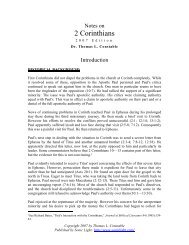1 Samuel - Odessa, Missouri Community of Christ
1 Samuel - Odessa, Missouri Community of Christ
1 Samuel - Odessa, Missouri Community of Christ
You also want an ePaper? Increase the reach of your titles
YUMPU automatically turns print PDFs into web optimized ePapers that Google loves.
32 Dr. Constable's Notes on 1 <strong>Samuel</strong> 2007 Edition2. National repentance and deliverance 7:5-14Mizpah (lit. watchtower, signifying anelevated site) was about two milesnorthwest <strong>of</strong> <strong>Samuel</strong>'s hometown,Ramah, on the central Benjaminplateau. 90 Pouring out water symbolizedthe people's feeling <strong>of</strong> total inability tomake an effective resistance against theirenemy (cf. Ps. 62:8; et al.). The peopleshowed that they felt a greater need tospend their time praying to strengthenthemselves spiritually than eating tostrengthen themselves physically. Theydid this by fasting (skipping a meal ormeals). 91 They admitted that what theyhad been doing was a sin against God(cf. 1 John 1:9). The writer described<strong>Samuel</strong> as one <strong>of</strong> Israel's judges similarto Gideon, Samson, and others, at thistime (cf. Judg. 6:25-27).The Israelites sensed their continuingneed for God's help and appealed to<strong>Samuel</strong> to continue to intercede for them(v. 8). <strong>Samuel</strong> gave intercession priorityTOWNS MENTIONEDIN 1 SAMUEL 7Central CanaanBethel*Bethcar (?) Mizpah*Gilgal (?)* *Kiriath-jearim* * Ramahin his ministry because he realized how essential it was to Israel's welfare (cf. 12:23). Allspiritual leaders should realize this need and should give prayer priority in theirministries. The sucking young lamb he sacrificed for the people represented the nation asit had recently begun to experience new life because <strong>of</strong> its repentance (v. 9). 92After the tabernacle left Shiloh, the Israelites may have pitched it at Mizpah. Since<strong>Samuel</strong> <strong>of</strong>fered a burnt <strong>of</strong>fering there (v. 9) perhaps that is where the tabernacle stood.Nevertheless at this time the Israelites made <strong>of</strong>ferings to God at other places too.God's deliverance was apparently entirely supernatural (v. 10) probably to impress thepeople with His ability to save them in a hopeless condition and to strengthen their faithin Him. Baal was supposedly the god <strong>of</strong> storms, but Yahweh humiliated him here. 93 Thelocation <strong>of</strong> Bethcar is still uncertain, but most scholars believe it was near Lower Bethhoron,about 8 miles west <strong>of</strong> Mizpah toward the Philistine plain.90 On the significance <strong>of</strong> the six-fold repetition <strong>of</strong> Mizpah in this story, see John A. Beck, "The Narrative-Geographical Shaping <strong>of</strong> 1 <strong>Samuel</strong> 7:5-13," Bibliotheca Sacra 162:647 (July-September 2005):299-309.91 On the practice <strong>of</strong> fasting, see Kent D. Berghuis, "A Biblical Perspective on Fasting," Bibliotheca Sacra158:629 (January-March 2001):86-103.92 The burnt <strong>of</strong>fering was an <strong>of</strong>fering <strong>of</strong> dedication, but it also served to make atonement (cf. 24:25; Lev.1:4; Job 1:5; 42:8).93 See Robert B. Chisholm Jr., "The Polemic against Baalism in Israel's Early History and Literature,"Bibliotheca Sacra 151:603 (July-September 1994):277.








